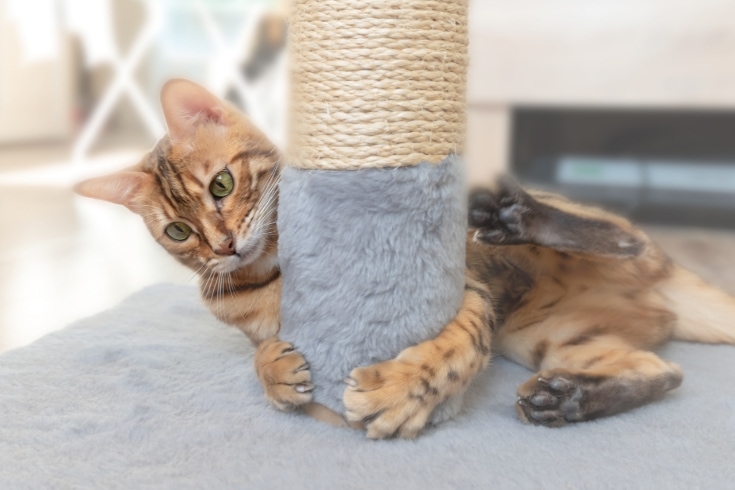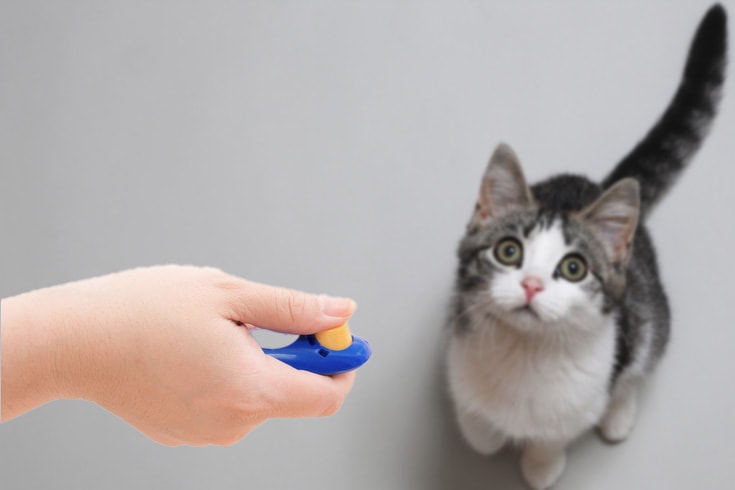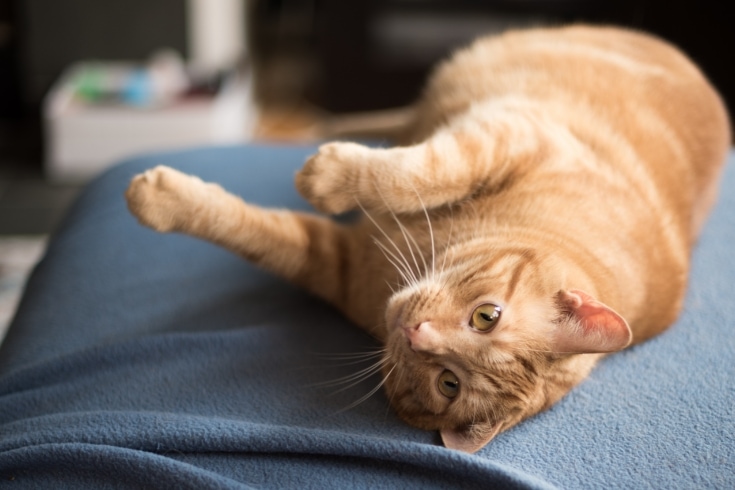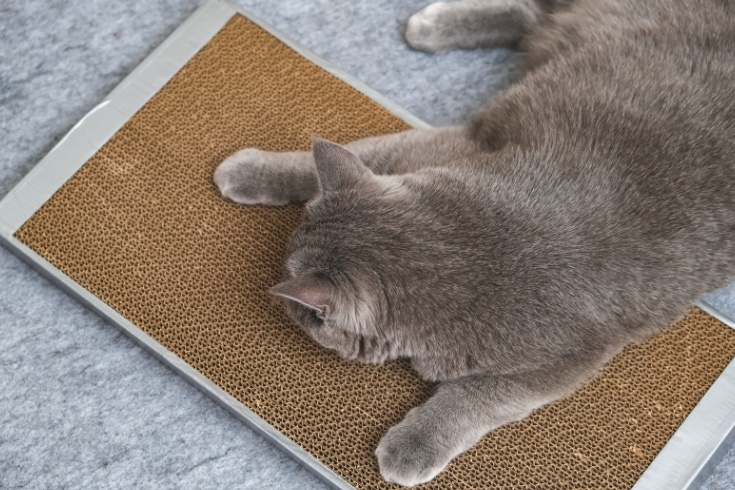Cat training means teaching your pet cat to learn certain desired behaviors, creating a bond between you and your pet and generally making your kitty a pleasure to have around.
The types and methods you can use to train your cat include positive reinforcement, repetition, and reward-based training. Cat training has many benefits for both cats and their owners, including litter box training, coming to call, leash training, scratch post training, and socialization.
You can even teach your cat a trick or two to impress your friends! For example, when I threw it for her, I trained one of my cats to fetch her toy mouse.
Rewards is the heart of any successful training. Be it tantalizing treats, a favorite squeaky toy, or a blissful head rub, rewards are like love letters that tell your cat, ‘Hey, you’re doing great!’.
Don’t forget about your trusty tools, your cat training sidekicks. We’re talking clickers that signal ‘good job!’, harnesses for safe exploring, and leashes for those exciting walkies!
Ready to discover the amazing world of cat training? Keep reading for a comprehensive deep dive into all things cat training, including some secret tips to make your training journey as smooth as your cat’s coat! Hold onto your tail, it’s going to be a thrilling ride!
What Are The Benefits Of Training Your Cat?
The benefits of training your cat are many and varied, and we discuss them in detail below.
Strengthen the bond with your cat

Some cats, especially stray or feral kitties, can be somewhat aloof and self-sufficient, and training your cat can help strengthen and build a better bond between you and your pet.
Provide physical exercise
Many older cats are quite lazy, preferring to spend their days lounging in a patch of sunlight and sleeping between trips to their food bowl! My cat, Spotty, is just like that, and he was in danger of getting fat, so I had to take action!
Luckily, Spotty loves to play with his cat teaser toy, so he has a couple of play sessions each day to provide him with the physical exercise he needs to keep him trim.
Stimulate your cat’s mind
Cats do get bored, especially if they can’t get outside to explore and hunt. Training your cat can help to stimulate his mind and prevent boredom from setting in.
Manage destructive behaviors
Some cats can resort to destructive behaviors, such as scratching your furniture, and training your cat to use a scratching post or mat can prevent that.
Maintain safety
An unruly cat can be a safety hazard around your home, especially if your cat likes to jump onto shelves, worktops, and your cooker hob!
You can train your cat not to get into dangerous situations, preventing accidents and keeping your home safer.
Easier vet visits

Most cats do not enjoy going to the vet, and that can make routine vet visits a stressful experience for everyone concerned.
Teaching your cat how to access being handled by strangers can make for easier vet visits.
Improved socialization
Some cats, especially those from rescue centers who have previously lived life on the streets, find being petted and generally handled frightening and stressful. You can train your cat to accept being stroked, picked up, and generally socialized.
Increase in trust
Training your cat typically involves using positive reinforcement techniques, including praise and treats, to reward desired behaviors.
Each time you reward your cat for performing a particular action, he learns to associate that behavior with a positive experience of some kind. Over time, the cat learns to trust that doing as you ask means a pleasant outcome, such as praise or a favorite yummy treat.
Improved indoor living
Several ways training your cat can lead to improved indoor living.
For example, although many cats enjoy spending time outside, most will live indoors for some of the time. Training your cat to use a litter box means that you won’t need to worry about your pet leaving messes in the house while you’re not around to let him out.
In addition, the last thing you want is for your cat to shred your favorite soft furnishings, and teaching your cat to use a scratching mat instead of your best Axminster rug, definitely means improved indoor living!
Enriched life
All in all, when you consider all the benefits listed above, you can see that training your cat can provide him with a much more fulfilling and enjoyable life.

What are the different types of cat training?
The most common types of cat training are basic obedience training, litter box training, socialization and behavior training, leash and harness training, and advanced training.
What are the basic commands for cats?
Basic cat commands are quite similar to those you would use when training a dog, although cats are more independent than dogs and can be less likely to follow your commands.
Here are a few basic commands you can teach your cat:
- “Sit”
- “Stay”
- “Come”
- “No!” or “Stop!”
- “Off” or “Down”
- Paws
- Shake
- High five
- Roll over
- Beg
- Fetch
You can also train your cat to respond to a clicker device, go into a crate, use a litter box, and walk on a leash, which is handy if you live in a busy traffic area and don’t want to risk allowing your cat outside unaccompanied.
When training your cat, be positive, consistent, and patient. Remember that every cat is unique; some will respond better to your cues and commands than others.
What is potty training for cats?

Potty training for cats teaches your cat to use a litter box to relieve himself. Litter training is actually pretty easy, as cats are clean animals that instinctively bury their pee and poop, so it’s natural for them to want to do their business somewhere they can hide it easily.
- You’ll need to provide a litter box that’s large enough for the cat to sit in comfortably but not so deep that a kitten struggles to get in and out of it.
- Choose a litter that the cat will use. Some cats won’t use wooden pellet litter; others prefer grit, while scented litter puts some cats off.
I once adopted a stray cat that didn’t understand what the litter box was for, preferring to relieve himself in my potted plants! The solution was simple; I sprinkled some soil from my garden over the litter in the box, and Royston used it straight away. - Position the litter box where the cats can easily find it but away from high-traffic areas.
- Some cats like a litter box with a lid that screens them from onlookers, while others don’t like the feeling of confinement and prefer an open box.
- Keep the litter box scrupulously clean! You wouldn’t be keen to use a dirty toilet, and neither is your cat. If you don’t change wet litter and remove solid waste frequently, your disgusted cat might resort to relieving himself in a quiet corner somewhere. The distinctive aroma of cat pee is notoriously difficult to get out of carpets, so be warned!
- Don’t overfill the litter box but don’t skimp either. I usually put an inch or so of grit in my cats’ litter box, which is fine.
Litter training is probably the most important aspect of cat training, so it’s important to get it right. Potty training your cat will give you peace of mind, save you time and effort in keeping your home clean and prevent health problems.
Socialization/Behavior Training

Behavior training teaches your cat what behaviors are acceptable to you and what behaviors are not. For example, scratching your furniture is not acceptable, whereas using a scratching post is fine.
Teaching your cats to behave in a certain way has lots of benefits. Your cats will be nicer to have around your home if they don’t soil or destroy it, and no one wants a cat that bites or scratches them when they stroke it.
A few examples of behavior training for cats include:
- Biting
- Scratching (you or your furniture)
- Jumping onto countertops
- Habituation Training
- Sensitization Training
- Counter-Conditioning
- Desensitization
- Positive Reinforcement
- Negative Reinforcement
- Human Interaction Training
- Multi-cat Socialization
- Environmental Familiarization
- Leash Training
- Exposure to Various Sounds and Textures
Socialization training is also important, especially if you have a multi-cat household or enjoy visits from neighboring cats in your garden.
Advanced Cat Training
Advanced training for cats includes more challenging commands that you can teach your cat once the basics are established.
Advanced cat training techniques and types include:
- Clicker training
- Lure training
- Leash/harness training
- Cat carrier/crate training.
- Trick Training
- Agility Training
- Fetch Training
- High-Five Training
- Puzzle Toy Training
- Target Training
- Voice Command Training
- Invisible Boundary Training
There are also a few fun tricks you can teach your cat to perform, such as retrieving toys, offering a paw, sit-up-and-beg, and rolling over.
Advanced training has many benefits, including making your cat easier to manage during vet visits, making traveling with your cat less stressful, and enabling you to give an indoor cat some valuable outdoor exercise.
What are tips when training your cat?

Some top tips for training your cats are discussed in this section of our guide.
Use positive reinforcement
Positive reinforcement training involves using rewards to encourage the cat to display the desired behavior in the future. The technique works by providing positive consequences immediately after the cat displays the desired behavior. That way, your pet understands that he will receive something nice when he responds to a command in a particular way.
Be consistent
In all aspects of your training, it’s essential that you are consistent. If you vary your cue words or constantly change the way you approach his training, your cat will become confused, and that will hamper the success of your training.
Keep training sessions short
Cats have a relatively short attention span and can become bored if their training sessions go on for too long.
So, I recommend keeping each training session between 15 and 20 minutes long rather than having one long session that might be too much for your cat.
Train in a quiet, distraction-free environment
You want your cat’s complete attention while you are training him. So, always choose a quiet area for your training sessions where you won’t be disturbed by other pets, kids, and outside distractions.
Use a clicker for precise timing
Clicker training demands an immediate response to your keywords and commands. For that reason, using a clicker device can really help to sharpen your cat’s response to your training instructions.
Start with simple commands

When you first start training your cat, stick to using simple, easy-to-understand commands rather than giving your pet complicated instructions.
That approach will make the training session more fun for you and your cat and probably be much more successful.
Be patient
Although training your cat can be very frustrating, especially if your pet keeps wandering away or simply lying down and going to sleep rather than responding to your commands, be patient!
Some cats learn much more quickly than others, so give your pet a chance, and don’t expect too much too soon.
Use high-value treats as rewards
If your cat is food motivated, you can use high-value treats as rewards for desirable behaviors. A tasty treat will encourage your cat to repeat the behavior to get another one!
Avoid punishment
No matter how frustrated you get, never use punishment when training your cat. If you punish your cat or scold him for getting something wrong, your pet will be less likely to respond positively to your cue words or commands in the future.
Train at the cat’s pace
All cats are different, and some learn more quickly than others. if your cat is very quick to learn, you can Forge your head with your training program. However, if your feline friend takes longer to understand what you want from him, be prepared to slow your training pace to suit your pet.
Make training fun

If you make the sessions fun, your cat will be much more likely to respond positively to his training. Try to use training techniques and exercises that the cat enjoys participating in, and avoid those he clearly hates!
Repeat training regularly
Part of your training strategy should involve regular repetition. So, be to hold regular training sessions, ideally several times a day rather than just once or twice a week. That way, your cat is more likely to remember the lessons he has learned, and your training has a good chance of being successful more quickly.
End each training session on a positive note
Every training session should end on a positive note.
If your cat is struggling to learn a new command, be prepared to go back a few steps and repeat a command that you know your pet understands and can respond to correctly. That way, every training session will finish with your cat being praised and rewarded for good behavior, making him more likely to approach the next session positively.
Respect your cat’s limits
Not all cats will be able to progress to learning more advanced training and tricks, so be prepared to respect your cat’s limits and keep within what he is able to do.
Train when your cat is attentive and not overly full or hungry
Don’t try to train your cat when he is hungry or has just scoffed a huge bowl of food!
Sometimes, keeping your cat’s attention is difficult enough, so choose a time when your pet will be most attentive to you.
Teach one command or trick at a time

Teach your cat one command, cue word, or trick at a time. If you try to include multiple commands in a training session, you will only confuse your pet and set yourself up for failure.
Use verbal cues consistently
Before you begin training your cat, choose a number of clear verbal cues that you will use in each training session.
Be careful to use the same verbal cues consistently so you don’t confuse your cat. Ensure that all your family members know the verbal training cues so that you can use them consistently.
Incorporate training into your cat’s daily routine
Training is usually more successful if you incorporate a couple of short sessions into your cat’s daily routine.
Gradually increase the difficulty of commands
As your cat’s training progresses, you can start to introduce more difficult commands. However, don’t be tempted to push ahead with your cat’s training before he has fully grasped the easier instructions you’re teaching him.
Involve all household members in training.
Your cat’s training will progress more quickly if everyone in your household is involved in his training. Ensure that all your family members know what verbal commands and cues you are using to train your cat and use them too.
What are common cat training tools and devices?

The common cat training tools and devices are:
- Clicker
- Harness and leash
- Puzzle toys
- Treats and other food rewards
- Target stick
- Scratching posts and mats
Whatever devices and training tools you choose, remember to be patient, consistent, and quick to praise your cat when he responds correctly to your commands.
Cat Training FAQs
Here are the answers to a few of the common cat training questions asked by pet owners.
Can you train a cat?
Yes, you can train cats, although that can take time, depending on the age and temperament of the kitty involved.
Are cats easy to train?
Cats are notoriously independent, so training them is not the easiest task, although it can be done with patience and perseverance.
Are cats trainable like dogs?
You can train cats to respond to simple commands, including “sit” and “come.” However, because of their independent nature, cats are typically not as easy to train as dogs.
In addition, many dog breeds were created specifically to help humans with various tasks, such as herding, guarding, hunting, or retrieving shot birds in the sporting field. Cats don’t have that background and are, therefore, generally not as trainable as dogs.
Are there cat trainers?
Yes, there are specialists known as cat trainers or cat behaviorists who have a good understanding of feline behavior, psychology, and communication and can be very helpful if you have problems training your cat.
Can cats be trained to do tricks?

Yes, you can train your cat to do simple tricks and obey simple commands, such as “sit,” “stay,” and “fetch!”
The key to successful cat training is to find your pet’s motivator. Some cats respond best to food rewards, whereas others prefer a cuddle or their owner’s affection. Be patient when training your cat, break each trick down into small sections to make it easy for your cat to understand, and keep each session short and sweet.
Can cats be trained to go outside?
You can teach your cat to go outside into your garden to do his business and do some exercise. The easiest way to do that is to invest in a catflap and train your cat to use it to go outside when he needs to.
Can cats learn commands?
Training cats to respond to basic commands is possible, although it’s easiest to do that when the cats are young.
I taught both my cats the “get down” and “no!” commands to train them not to jump onto my table at dinner time and to stop emptying the soil out of my potted plants all over the living room carpet!
Can you house-train a cat?
All my cats, even the kittens, came ready house-trained! Cats are very clean creatures and are usually willing to use a litter box without being specifically trained to do so.
That said, if you take a cat from a rescue or shelter, check what kind of litter the cat is used to, as some cats won’t use wooden litter if they’re accustomed to using grit.
Can you leash-train an older cat?
You can train an older cat to walk on a leash, although it’s more challenging than teaching a kitten. You’ll need to be extremely patient and take the process step-by-step until the cat understands what’s required, using plenty of rewards and praise as you go.
Can you teach a cat to sit?

Although cats are generally not as easy to train as dogs, you can train a cat to “sit” on command. Again, you must take your time and not expect results overnight.
Can you train a cat not to bite?
Cats bite for several reasons, including in play, when frightened, and during petting.
First, you need to identify what’s triggering your cat to bite. Once you’ve worked out why your cat bites, redirect the cat to biting something else; for example, if the cat bites you when you’re playing with him, offer a toy instead of your hand.
Give your cat lots of chew toys to bite, and avoid rough play involving your hands and feet that could encourage your cat’s biting behavior.
What if my cat isn’t food motivated?
If your cat isn’t interested in food treat rewards, use an alternative, such as a play session, cuddles, head rubs, and the like.
One of my cats isn’t interested in treats but she loves being petted. So, when I’m training her, I always make a big fuss of her when she responds positively to my commands and cues.
What if I have multiple cats?
Having several cats can actually be quite helpful when training them. For example, you can allow one cat to watch the other being trained as a form of experiential learning.
Of course, that can backfire if the cat being trained is disobedient and willful, as that sets a very bad example to the onlooker!
Which behavior should I start with?
I always start by ensuring my cats are litter trained. Usually, using a litter box is a very easy thing to teach any cat as cats naturally bury their waste when outside, so it’s a small leap to start using a litter box.
Conclusion
Although cats are more independent than dogs, you can still teach your feline friend some basic commands, cues, and desirable behaviors. Cat training helps to create a loving bond between you and your pet and improves your cat’s behavior.
You should always use positive reinforcement and reward-based training methods to reap the benefits of cat training, including litter box and scratch post-training, socialization, and walking on a leash. Tools such as clickers, leashes, harnesses, and leashes are handy training devices you can use, too.
What tricks did you train your cat to do? Tell us about your feline friend in the comments box below!